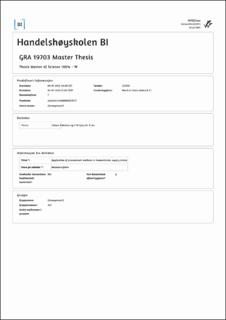| dc.contributor.author | Zobnina, Alona | |
| dc.contributor.author | Tran, Chi Quynh | |
| dc.date.accessioned | 2023-11-13T12:08:30Z | |
| dc.date.available | 2023-11-13T12:08:30Z | |
| dc.date.issued | 2023 | |
| dc.identifier.uri | https://hdl.handle.net/11250/3102169 | |
| dc.description | Masteroppgave(MSc) in Master of Science in Business, Logistics, operations and supply chain management - Handelshøyskolen BI, 2023 | en_US |
| dc.description.abstract | The increasing number of crises in recent times has put tremendous pressure on humanitarian organizations and their procurement functions. While striving to streamline supplies for humanitarian operations, procurement functions are often challenged by multiple factors intrinsic to the humanitarian context. How procurement functions can avoid such challenges and improve the efficiency and effectiveness of the procurement process has always been of great interest. As procurement methods are integral parts of the procurement process, this study investigates the application of procurement methods in humanitarian supply chains to explore opportunities for improving the procurement process.
We conducted a case study on World Vision (WV) and its procurement practice to generate in-depth insights for our research questions. Qualitative data was collected from semi-structured interviews with supply chain personnel in national and regional offices in WV. Our interviews explored not only procurement methods and their application but also relevant theories in humanitarian procurement to acquire further contexts. Moreover, data from WV’s internal documents and website was also collected to help strengthen and complement our findings.
The main finding of our thesis is the proposed differentiation of procurement methods. Defining the application of procurement methods based on financial thresholds alone overlooks the fact that not all products and services are the same. With the Kraljič portfolio matrix (KPM) as the reference for categorizing products and services, recommended procurement methods for the four quadrants were retrieved. Strategic sourcing and competitive tendering process are found to be the most recommended procurement methods. It is also significant to note that the recommendations of procurement methods for the four quadrants do not always align with the strategies proposed in the literature. Findings generated on the differentiation of procurement methods in our thesis can be referred to by humanitarian organizations to re-design the procurement policy on procurement methods and by supply | en_US |
| dc.language.iso | eng | en_US |
| dc.publisher | Handelshøyskolen BI | en_US |
| dc.subject | operations | en_US |
| dc.subject | supply chain management | en_US |
| dc.title | Application of procurement methods in humanitarian supply chains | en_US |
| dc.type | Master thesis | en_US |
